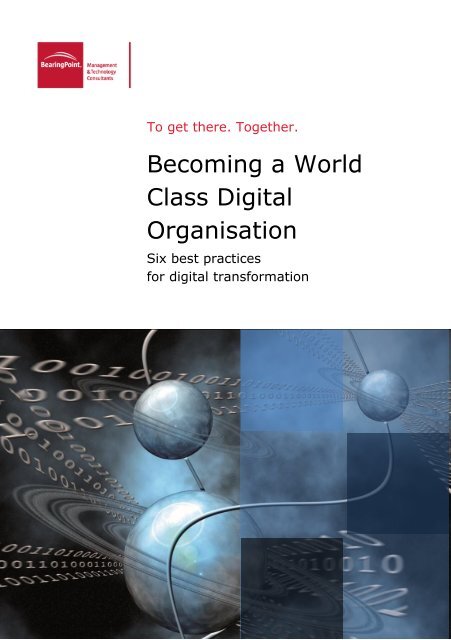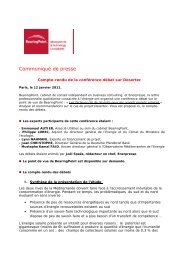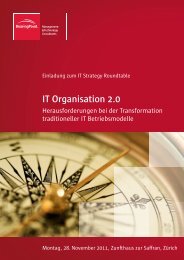Becoming a World Class Digital Organisation - BearingPoint
Becoming a World Class Digital Organisation - BearingPoint
Becoming a World Class Digital Organisation - BearingPoint
Create successful ePaper yourself
Turn your PDF publications into a flip-book with our unique Google optimized e-Paper software.
To get there. Together.<br />
<strong>Becoming</strong> a <strong>World</strong><br />
<strong>Class</strong> <strong>Digital</strong><br />
<strong>Organisation</strong><br />
Six best practices<br />
for digital transformation
Contents<br />
Methodology 2<br />
THE DIGITAL FUTURE IS HERE AND NOW 3<br />
Six best practices for digital transformation 4<br />
#1 - Develop an incremental digital journey 4<br />
#2 - Define the rules for digital 7<br />
#3 - Increase agility to overcome structural inertia 9<br />
#4 - Dare to fail 12<br />
#5 - Prioritise what you measure,<br />
measure what you prioritise 14<br />
#6 - Build your digital business on data insights 19<br />
Conclusion 22<br />
Contact details 23<br />
1
METHODOLOGY<br />
<strong>BearingPoint</strong> undertook a comprehensive study of <strong>World</strong> <strong>Class</strong><br />
<strong>Digital</strong> companies through primary interviews, market research and<br />
a global survey covering Europe, North America and Asia Pacific.<br />
The focus of this study was to assess and understand how these<br />
companies organise their internal digital teams and capabilities to<br />
enable digital transformation and delivery of digital engagement<br />
with their customers and partners.<br />
The 25 companies included are defined as <strong>World</strong> <strong>Class</strong> <strong>Digital</strong><br />
through their standing in respective industries and their exemplary<br />
demonstration of successful innovation and engagement in the<br />
digital world. Focus areas for digital activity range from marketing to<br />
acquisition, from servicing to cross/up sell, and from customer<br />
satisfaction to market influence.<br />
Industries covered in the survey include financial services,<br />
telecommunication, retail, software services, consumer electronics<br />
and internet services. For the purpose of analysis, they were split<br />
into three segments:<br />
� <strong>Digital</strong> companies<br />
� Financial services companies<br />
� Other companies<br />
Furthermore, the study distinguishes two different patterns:<br />
� The <strong>Digital</strong> Pure Players, companies that have been<br />
designed for digital from inception and exclusively use digital<br />
without any physical channels<br />
� The <strong>Digital</strong> by Evolution companies are those that have<br />
evolved over time and have moved away from physical<br />
channels in favour of newly developed digital ones<br />
Finally, we would like to thank all the participants and contributors<br />
for their valuable time and insights. We hope that these findings will<br />
assist them as they respond to the changing digital world.<br />
Point of view<br />
2
THE DIGITAL FUTURE IS HERE AND NOW<br />
Gone are the days when a standalone website was sufficient to<br />
constitute an online business presence. Today, a fully interactive<br />
and engaging end-to-end digital customer experience is not only the<br />
norm, but the minimum expected from customers across all<br />
industries.<br />
With the emergence and establishment of key digital players,<br />
together with changing customer behaviours exacerbated by device<br />
mobility and perpetual connectivity, the digital landscape is rapidly<br />
evolving. The pace of this digital change is phenomenal – and the<br />
opportunity therein even more so.<br />
To maintain competitiveness and ensure long term success,<br />
businesses must ensure that their organisation is ready and capable<br />
to meet challenges faced in the digital world, to respond to<br />
customer needs, and where possible, define the future of digital<br />
engagement.<br />
Moving beyond existing studies focused on external digital customer<br />
experiences, comprising of online functionality and “look & feel” for<br />
customers, companies need to understand what is required<br />
internally to enable successful delivery of digital into the<br />
marketplace. This ranges from culture and behaviours to<br />
organisational capabilities and structure.<br />
This digital wave has driven fundamental changes and the journey<br />
towards digital effectiveness is specific to each organisation.<br />
However, <strong>World</strong> <strong>Class</strong> <strong>Digital</strong> companies can provide fundamental<br />
lessons and key insights that should be adopted on the journey to<br />
digital transformation.<br />
3
SIX BEST PRACTICES FOR DIGITAL TRANSFORMATION<br />
#1 - DEVELOP AN INCREMENTAL DIGITAL JOURNEY<br />
� The development of an integrated global strategy reflects<br />
a homogenous business model delivered through digital<br />
channels<br />
To ensure consistency with local demographics, customer<br />
affluence and maturity and their channel preferences, <strong>Digital</strong> by<br />
Evolution companies tend to develop a global strategy that is<br />
highly tailored locally – 50% of the Non-Financial Services<br />
companies and 70% of the Financial Services companies. To<br />
guarantee the success of the implementation of the strategy,<br />
activities executed at regional and country level are adjusted to<br />
local specificities.<br />
Level at which digital strategy is built<br />
Those <strong>Digital</strong> by Evolution companies which are spun-off from<br />
traditional brick & mortar firms, are strongly linked to their<br />
parent companies in terms of culture, ways of working and<br />
ethos, although they do apply separate business and digital<br />
strategies.<br />
Point of view<br />
4
Integrated strategies<br />
Separate strategies<br />
Level of integration of digital strategy<br />
In contrast, 100% of <strong>Digital</strong> Pure Players deploy global,<br />
integrated strategies: digital<br />
strategy and business strategy<br />
are one and the same. There is<br />
no separation between the two<br />
types of strategy; digital is<br />
intrinsic to these companies.<br />
Consequently, key strategic<br />
objectives are defined at a global<br />
level and then deployed by each<br />
country for their local market.<br />
Any local variations remain<br />
closely aligned to the global<br />
strategy and approach.<br />
We do not refer to<br />
“digital”, neither do we<br />
have separate “digital”<br />
training, or separation of<br />
digital and business<br />
strategies; it is a<br />
fundamental part of who<br />
we are and part of<br />
everything we do<br />
� Focus and emphasis on consistent customer experience<br />
over specific digital channel ownership<br />
Today, companies are adopting a more customer centric<br />
approach. Regardless of where digital ownership lies within or<br />
across the organisation, delivering a consistent brand and<br />
customer experience to the customer prevails. It has become a<br />
true differentiator for companies.<br />
In the <strong>Digital</strong> by Evolution model, digital ownership is often split<br />
between different teams. Examples of this are digital<br />
5
and non-digital channel teams, or Marketing and Ecommerce/<strong>Digital</strong><br />
solutions teams.<br />
However, despite this split digital expertise is often organised in<br />
a centre of excellence (CoE). The objective is then to have a<br />
dedicated digital team within the CoE; they provide digital<br />
support and guidance to all product teams and functions within<br />
the organisation, and ensure a higher level of consistency in<br />
terms of experience and message across all channels and<br />
customer interactions.<br />
When it comes to <strong>Digital</strong> Pure Players, providing a consistent<br />
customer experience is ensured globally through management<br />
of standards and guidelines, as well as being reinforced through<br />
the brand (both internally and externally). <strong>Digital</strong> is then either<br />
owned by a single person or by “all employees”, as they are all<br />
responsible for digital within their specific functions and areas.<br />
Best practice 1<br />
Business and digital strategies need only be combined and<br />
integrated once intrinsic digital maturity and capability has<br />
been achieved. A global digital vision should be deployed<br />
with local execution.<br />
Point of view<br />
6
#2 - DEFINE THE RULES FOR DIGITAL<br />
� Effective delivery of digital capability is closely correlated<br />
with clear definition of digital principles and<br />
organisational ownership<br />
Analysing the level of organisational digital dissemination<br />
indicates how far a company is in its digital transformation. This<br />
evolution occurs predominantly in the <strong>Digital</strong> by Evolution<br />
model. These companies must ensure that digital rules,<br />
guidelines and principles are first defined, then disseminated<br />
and truly embedded in all teams.<br />
For companies with emerging digital maturity, organisational<br />
set-up is usually in mixed teams, ranging from centralised and<br />
decentralised, to region specific, as well as digital teams at<br />
specific group/function level. This model is mainly in place in<br />
Financial Services companies.<br />
<strong>Organisation</strong>al digital dissemination path<br />
<strong>Organisation</strong>s then move away from pockets of mixed<br />
ownership, ensuring smooth transition through the<br />
implementation of a digital centre of excellence. The aim is to<br />
promote a consistent and standardised digital knowledge base.<br />
This type of organisation creates a more effective use of<br />
resources by pulling information from all required areas whilst<br />
developing them appropriately. Interactions and collaboration<br />
7
etween key groups are then developed. This approach<br />
encourages new methods and technologies that creates a<br />
favourable environment for product and process diversification,<br />
as well as innovation.<br />
The ultimate organisational model to enhance digital adoption is<br />
to have digital embedded throughout, as seen in the <strong>Digital</strong><br />
Pure players. There is no need to set up a centralised digital<br />
organisation as all teams are digital by definition. <strong>Digital</strong> culture<br />
is naturally widespread within the organisation.<br />
Best practice 2<br />
How teams are organised<br />
Establish a digital centre of excellence to create and enforce<br />
guidelines and principles as part of your digital transition<br />
until digital is embedded and fundamental throughout your<br />
organisation<br />
Point of view<br />
8
#3 - INCREASE AGILITY TO OVERCOME STRUCTURAL INERTIA<br />
� Responsive and agile digital delivery is enabled through<br />
physical and collaborative integration between teams<br />
Agility is imperative for organisations: they need to build and<br />
maintain a strong culture to develop its identity, but, at the<br />
same time, they have to remain responsive to dynamic<br />
environments and seize the opportunity to initiate or to react to<br />
environmental change. Agility is thus a mix of stability and<br />
reorganisation whist coping with internal coherence.<br />
Encouraging cohesion, organisational commitment, and<br />
desirable work behaviours among members is therefore<br />
fundamental to creating the baseline of the organisation.<br />
Path to create true integrated collaboration<br />
In Financial Services, IT and business teams are often physically<br />
separated: for more than 60% of respondents, teams are<br />
located separately within offices, between offices, and often<br />
geographies. The mode of working between them is that of<br />
customer and supplier; primarily through IT responding to<br />
business requests. Collaboration is low and people rarely<br />
request help from others, fearing that it is perceived as an<br />
admission of incomprehension or lack of knowledge.<br />
9
Location of business and IT<br />
For 60% of <strong>Digital</strong> Pure Players,<br />
agility is provided through physical<br />
and cultural integration of IT and<br />
business teams. This enables a true<br />
collaboration to build upon and<br />
support each other’s ideas and<br />
pledge resources. IT and business<br />
teams partner collaboratively<br />
throughout the lifecycle, from<br />
concept and feasibility assessment,<br />
through to development, delivery<br />
and improvement.<br />
We provide breathing<br />
space to develop and<br />
work on new ideas,<br />
everyone is encouraged<br />
to innovate. We actively<br />
support this by giving<br />
everyone 20% of their<br />
time to work on pet<br />
projects<br />
� <strong>Digital</strong> innovation is the responsibility of everyone, not<br />
just discrete teams<br />
Growth depends on innovation, and innovation depends on an<br />
open flow of ideas. So organisations have to harness and<br />
develop strategies to encourage creativity.<br />
For <strong>Digital</strong> by Evolution companies, structure for innovation<br />
varies. Siloed teams within organisations still exist where<br />
innovation is seen as being under the ownership of business<br />
Point of view<br />
10
teams that deliver to market. While such teams are used to<br />
work in isolation in the past, the trend is for the development of<br />
Businesses are<br />
reorganising around<br />
people. Technology<br />
enabled collaboration<br />
with external stakeholders<br />
helps organisations gain<br />
market share from<br />
competition<br />
that continuously develops creative<br />
teams to run and sustain the end to end<br />
process. All employees are innovative<br />
and are encouraged to take part in the<br />
innovation process. When an idea is<br />
developed an ad-hoc, dedicated<br />
innovation team is set up with all<br />
interested contributors. All members of<br />
the team bring their own expertise. This<br />
team is not isolated, it partners with the<br />
business to deliver new products and<br />
digital innovation to be<br />
increasingly in collaboration with<br />
the business. In the integrated<br />
model, the team is responsible for<br />
incubating ideas, and working<br />
with the business to develop them<br />
further to bring to fruition.<br />
The most advanced model is in<br />
<strong>Digital</strong> Pure Players companies.<br />
They have established a structure<br />
Previously, some<br />
innovations took so<br />
long to incubate<br />
and develop, that<br />
by the time they<br />
reached the market<br />
they were no long<br />
innovative nor<br />
relevant!<br />
services, sharing working ideas. A key factor in this digital<br />
segment is that innovation is not exclusively owned by the<br />
innovation teams that exist; but rather, all staff are asked to<br />
own, innovate and build on ideas.<br />
Creativity also depends on how managers encourage and exploit<br />
diversity in the organisation. Managers allow and encourage<br />
employees to take up to 20% in some organisations of their<br />
working time to develop ideas, as well as own and drive them<br />
forward.<br />
11
Best practice 3<br />
Integrate delivery and business teams throughout the<br />
innovation and development process, ensuring true<br />
collaboration and promoting innovation ownership<br />
Point of view<br />
12
#4 - DARE TO FAIL<br />
� <strong>World</strong> class digital culture liberates passion and talent by<br />
accepting risk as a part of the iterative route to success<br />
No one likes to fail: we have been conditioned to think that<br />
failing is unacceptable. However it is through repeated failures<br />
and learning more from the failure that the greatest innovations<br />
have been created. Culturally, for at least one of the <strong>Digital</strong><br />
Pure Players, unless a new recruit can demonstrate that they<br />
have taken a risk, failed and learnt from that failure, they will<br />
not be hired.<br />
In conservative companies such as<br />
Financial services with a culture of<br />
hierarchy and command and control,<br />
innovation is a complex dilemma and<br />
not an easy one to solve. Financial<br />
Services firms operate under an<br />
increasingly strict regulatory regime,<br />
and even if people are willing to<br />
innovate, there are reservations<br />
concerning the activity; whilst<br />
innovation is encouraged in principle,<br />
We dare to fail – not<br />
shambolic public<br />
multi-million dollar<br />
failures – but we<br />
accept that not<br />
everything works first<br />
time, and our people<br />
know this<br />
it is restrained by the desire to avoid risk and the fear of the<br />
consequences of failure. This culture is as fundamental to<br />
ensure quality and accountability, but hinders rapid<br />
development and delivery into new areas.<br />
Innovation therefore, encompasses the process of examining<br />
things that potentially could work and then either rejecting<br />
them or evolving them into something that really does work. It<br />
is especially true when you start to explore, to experiment and<br />
to create something new. Most successful companies embrace<br />
failure, making deliberate efforts to create a culture where<br />
people can feel comfortable about failing.<br />
13
Pure <strong>Digital</strong> Players not only accept but expect risk and failure<br />
as part of the innovation process. Beta versions are deployed to<br />
users for early feedback and to influence the final version.<br />
Leadership commits to and supports ideas, and accepts that<br />
taking risks is part of the iterative route to success.<br />
� <strong>World</strong> class digital organisation have an inherent digital<br />
culture, embed knowledge, reward innovation and recruit<br />
digital expertise<br />
<strong>Organisation</strong>al culture is key for successful business as it<br />
assembles a set of shared beliefs, norms, and values.<br />
<strong>Organisation</strong>al culture is formed over years of interaction<br />
between the participants in the company. Developing a digital<br />
culture can, therefore, present a challenge.<br />
For <strong>Digital</strong> by Evolution businesses, changing existing culture is<br />
far more difficult than for organisation built from scratch in the<br />
digital space. Established norms create a vastly different culture<br />
in comparison to <strong>Digital</strong> Pure Players companies.<br />
In <strong>Digital</strong> by Evolution businesses, digital is treated as a<br />
standalone entity and is used as a bolt-on to general training or<br />
through induction of employees when required for specific roles.<br />
<strong>Digital</strong> knowledge is deemed to be role specific, and not spread<br />
throughout the whole organisation.<br />
How staff are trained and educated around digital<br />
Point of view<br />
14
However, Financial Services organisations do develop refresher<br />
courses for encouraging digital thinking and raising awareness.<br />
For <strong>Digital</strong> Pure Players, digital is core to the culture. It is<br />
fundamental and required at recruitment. Deep technical skills,<br />
true passion for the internet, and a hunger for innovation is<br />
Hire the best people,<br />
and expect the best<br />
from our people<br />
essential. As digital is a fundamental<br />
part of the business, there is no need<br />
to incentivise digital adoption<br />
specifically. All training is digital and is<br />
mostly provided as part of the<br />
induction process.<br />
Regular sessions on product innovation, industry trends and<br />
insights are used to encourage broadening and deepening of<br />
knowledge and expertise, along with role specific training.<br />
<strong>Digital</strong> know-how is seen as inherent and is included in all<br />
training.<br />
Innovation is favoured, rewarded and encouraged through using<br />
a broad range of methods encompassing monetary and nonmonetary<br />
incentives.<br />
Best practice 4<br />
Drive cultural change through demonstrated commitment<br />
from leadership, and recruitment of digital expertise<br />
15
#5 - PRIORITISE WHAT YOU MEASURE, MEASURE WHAT<br />
YOU PRIORITISE<br />
� Define, implement and monitor consistent KPIs to ensure<br />
business and customer relevance and competitiveness<br />
Key Performance Indicators (KPIs) are used to ensure that<br />
projects are clearly aligned and contribute to the strategic goals<br />
of the organisation.<br />
KPI used to determine the success of the digital strategy<br />
<strong>Digital</strong> by Evolution companies focus on internal measures;<br />
Financial Services organisations more so on financials and costs.<br />
Achieving financial objectives, maximising market share, and<br />
reducing costs are the main criteria for assessing business<br />
cases. Thus projects are mainly prioritised on financial criteria<br />
as well as increasing their competitiveness in the market.<br />
Non-Financial Services<br />
organisations focus on<br />
financials and optimisation.<br />
As these companies are<br />
managed mainly taking an<br />
inside out view (company<br />
first) vs outside in<br />
(customer first), project<br />
We have clear objectives<br />
and metrics about what we<br />
want to achieve prior to<br />
entering the channel, as<br />
opposed to saying ‘we want<br />
to use Twitter’<br />
Point of view<br />
16
prioritisation is based on optimising their value chain. Key<br />
criteria for business cases are financial, such as increasing<br />
revenues and profitability, as well as competitiveness.<br />
Top 3 Project prioritisation elements<br />
As for <strong>Digital</strong> Pure Players<br />
companies, the customer and<br />
innovation are the main focus.<br />
Capturing the customer view, in<br />
terms of what they desire, and/or<br />
whether they will adopt and<br />
recommend, is key in project<br />
prioritisation. The strategy is to<br />
drive higher revenue by attracting<br />
the most customers.<br />
Competitiveness driven through<br />
innovation is also a high priority;<br />
being first to enter a new market,<br />
shaping trends, timeliness and<br />
relevance.<br />
We plan and prioritise<br />
our work based on<br />
what is relevant to<br />
our customer now – if<br />
a project is not<br />
important or relevant<br />
enough to be green lit<br />
the first time round,<br />
digital moves so fast<br />
it is unlikely be<br />
relevant when we<br />
next go through the<br />
cycle<br />
17
� Measure project success based upon key prioritisation<br />
criteria<br />
Defining KPIs creates impartiality in project selection by giving a<br />
rationale behind selecting projects, putting them on hold or<br />
even cancelling them.<br />
For <strong>Digital</strong> by Evolution companies, customer sentiment KPIs<br />
are often used to assess digital customer satisfaction and<br />
loyalty. However these KPIs are not reflected in the key decision<br />
criteria for Financial Services project prioritisation. Therein lays<br />
a true dissonance between how projects are prioritised - on<br />
financial KPIs - and how project results are measured. It might<br />
end by launching projects with financial opportunities that are<br />
not aligned with customer expectations.<br />
Conversely, <strong>Digital</strong> Pure Players measure project success based<br />
on key prioritisation criteria. Customer<br />
sentiment KPIs are used most frequently as<br />
their business model is to develop products<br />
in line with customer requirements and<br />
adoption. Project prioritisation criteria are<br />
aligned with these KPIs as these companies<br />
adopt a customer focus and centricity approach. While<br />
important, financials are not the deciding factor in prioritisation<br />
but rather customer demand and innovation relevance/<br />
timeliness. However, financial KPIs are also key for these<br />
companies given that digital is their primary (and often only)<br />
channel for business.<br />
� Regular planning and prioritisation enables incorporation<br />
of latest trends and customer feedback, ensuring<br />
timeliness and relevance of delivery<br />
Demand volatility is exacerbated by shifts in customer<br />
behaviour, consumer awareness, individual preferences and<br />
distribution patterns. New challenges emerge for organisations:<br />
they need flexibility and agility to align with customer<br />
expectations. However, ensuring timeliness, relevance and<br />
Point of view<br />
18
delivery responsiveness provides a great opportunity for growth<br />
for those who can anticipate and capture customers during<br />
these shifts.<br />
Commodity based businesses – <strong>Digital</strong> by Evolution companies<br />
– have to manage their supply chain to deliver products and<br />
services. Demand management is often complex with<br />
distribution and planning processes fragmented. <strong>Organisation</strong><br />
flexibility becomes low and as a result it becomes more<br />
challenging to deliver the right product at the right location at<br />
the right time.<br />
Quarterly<br />
Biannually<br />
Monthly<br />
Annually<br />
Frequency of digital plan refreshment<br />
An integrated and responsive supply chain is key to becoming<br />
competitive as is adopting a more consumer-centric approach.<br />
<strong>Organisation</strong>s can then provide a more accurate and consistent<br />
offering to increasingly savvy customers who expect their<br />
demands to be met in whichever location and through<br />
whichever channel their prefer.<br />
<strong>Digital</strong> Pure Players have established short, monthly digital<br />
project plan cycles and help focus effort and enable effective<br />
responses to what customers want the most.<br />
Lessons can be learnt faster and iterations produced quicker -<br />
beta products can be improved and completed. Shorter planning<br />
cycles will also ensure customer and market timeliness and<br />
relevance.<br />
19
� The voice of the customer is key for product and<br />
experience improvement, with feedback utilised in a<br />
framework of listen, learn, and act<br />
The voice of the customer is key in relation to the continuous<br />
improvement of customer experience. <strong>Organisation</strong>s should<br />
derive a roadmap from customer feedback in order to identify<br />
items to address and realise even greater commercial success in<br />
the future. The focus should be to optimise the relationship<br />
between the organisation and the customer, ensuring efficiency,<br />
longevity and to make customers feel that they are empowered<br />
and are in the heart of the development / improvement process.<br />
Collecting customer feedback<br />
Financial Services organisations prefer an inside-out approach,<br />
pushing products and services to customers, with the goal of<br />
increasing financial return. Shareholder value is often prioritised<br />
over immediate customer needs, except for where regulation<br />
dictates.<br />
<strong>Digital</strong> Pure Players have embedded a culture of testing, where<br />
they allow customer to make decisions that will ultimately lead<br />
to an increase in conversion rate. To ensure the most accurate<br />
response to customer preferences, tests occur almost<br />
continuously. <strong>Digital</strong> channels are predominantly used to collect<br />
feedback, although physical channels are also utilised.<br />
Point of view<br />
20
Web monitoring is the most used method amongst all <strong>Digital</strong><br />
Pure Players. Less automated methods are also deployed such<br />
as social media monitoring and email surveys. Both positive and<br />
negative feedback is collected and used to optimise the<br />
customer experience: negative feedback builds authenticity and<br />
creates trust in the brand, (what is<br />
When companies stay<br />
close to their<br />
customers, powerful<br />
real time insights feed<br />
into future planning<br />
and product<br />
development. When<br />
our customers speak<br />
we listen<br />
Best practice 5<br />
bad for one might not be for<br />
others), and ignoring negative<br />
feedback will not make it go away.<br />
Outside-in focus is chosen, taking<br />
into consideration what customers<br />
need and want, and working to<br />
exceed expectations. Capturing<br />
multi-channel customer feedback<br />
for continuous service and product<br />
improvement is essential.<br />
Customer experience should become a key criterion for<br />
project prioritisation, facilitated by continual review of digital<br />
plans and priorities to enable effective response to market<br />
and customer needs<br />
21
#6 - BUILD YOUR DIGITAL BUSINESS ON DATA INSIGHTS<br />
� Effective data analytics is the engine to drive targeted<br />
marketing and customer personalisation<br />
Amassing data across disparate channels has been facilitated for<br />
companies as a result of the massive amount of available data<br />
inside and outside the enterprise. This includes everything to do<br />
with customer sentiment and opinion, customer-to-customer<br />
communications through blogs, Twitter and social media sites.<br />
In most organisations, customer information is distributed and<br />
duplicated across various applications; there is no unique view<br />
of the information. Effective customer management requires<br />
accurate, integrated and up-to-date<br />
customer information.<br />
The challenge is how all of this<br />
information is connected and how<br />
well the data is utilised to make the<br />
right decisions.<br />
Only half of Financial Services<br />
respondents have an integrated<br />
customer database. Investing in this<br />
area and in analytics would result in a more intelligent use of<br />
customer data and increased ability to target consumers with<br />
the right product at the right time. Although a huge amount of<br />
data is captured and stored by Financial Services respondents,<br />
it is not always leveraged or used effectively.<br />
In other <strong>Digital</strong> by Evolution companies, investments are being<br />
made in data and analytics as these companies increasingly<br />
recognise the value of having a more integrated view of their<br />
customers.<br />
Point of view<br />
22
Yes<br />
No<br />
Yes No<br />
Integrated databases<br />
Superior analytical capabilities distinguish some of the top<br />
companies. As best in class, all <strong>Digital</strong> Pure Player respondent<br />
companies have an integrated database for all customer<br />
interactions (including cross channel) and capture real time<br />
customer data. This data is accessible by all service agents for<br />
interactions with customers. In addition, data analytics drives<br />
and shapes personalised and targeted marketing.<br />
� Product design evolves by combining digital data insights<br />
with real time feedback through a continuous customer<br />
dialogue<br />
Intelligence and knowledge from data and analytics is used to,<br />
understand, target and engage customers.<br />
<strong>Digital</strong> data insights consist of collecting, analysing, and<br />
distilling data from a wide variety of sources. <strong>Digital</strong> data<br />
analytics provides statistical insights and real-time suggestions<br />
for optimal decision-making and real-time mining to coordinate<br />
Yes<br />
No<br />
23
more agile responses. Additionally, they enable understanding<br />
customer behaviours, creating simulations based on the<br />
ecosystem. This scenario analysis explores the effect of<br />
variables in production/delivery and its impacts on customer<br />
behaviours, and by extension on business. Contingency plans<br />
are then developed to mitigate the most likely disruptive<br />
events.<br />
Two-way dialogues between companies and their customers can<br />
maximise customer relationships. Customer dialogue provides a<br />
platform for users to interact with one another in a structured<br />
way. Communities enable collaboration between employees,<br />
customers, suppliers, third parties, commerce platforms and<br />
content platforms. Requirements and prioritises are thus easily<br />
set up and product development is more relevant and aligned<br />
with customer expectation<br />
Best practice 6<br />
Build a holistic data management approach to capture,<br />
analyse, and leverage customer data across all touchpoints<br />
to tailor communication, marketing offers and service<br />
propositions<br />
Point of view<br />
24
CONCLUSION<br />
Different types of organisations in different industries have diverse<br />
approaches and perceptions around realising a digitally enabled<br />
business and culture. As levels of digital maturity, capability,<br />
appetite and opportunity inevitably vary, “a one size fits all<br />
approach” to digital transformation does not truly exist.<br />
However, through this study of <strong>World</strong> <strong>Class</strong> <strong>Digital</strong> companies, 6<br />
best practices for digital transformation have been established as<br />
the common thread underpinning their respective digital successes.<br />
The world class trends and principles identified here need to be key<br />
considerations as part of any digital journey, taking into account<br />
positioning within each best practice, and levels of maturity within<br />
them.<br />
Applying each best practice in turn and as a whole for your<br />
organisation will help shape and define your journey and road map<br />
to achieve world class digital transformation, thus enabling an<br />
organisation to become a truly competitive and pioneering in the<br />
digital world.<br />
<strong>Digital</strong> is the future – and tomorrow is already here.<br />
25
We deliver Business Consulting. We are an independent firm with European<br />
roots and a global reach. In today’s world, we think that Expertise is not<br />
enough. Driven by a strong entrepreneurial mind-set and desire to create<br />
long term partnerships, our 3200 Consultants are commitment to creating<br />
greater client value, from strategy through to implementation, delivering<br />
tangible results. As our clients’ trusted advisor for many years (60% of<br />
Eurostoxx 50’ and major public organisations), we define where to go and<br />
how to get there…<br />
To get there. Together.<br />
CONTACT DETAILS<br />
Sarah-Jayne Williams<br />
Phone: +44 (0) 7968 796915<br />
Email: sarah-jayne.williams@bearingpoint.com<br />
Andreas Rindler<br />
Phone: +44 (0) 79175 53262<br />
Email: andreas.rindler@bearingpoint.com<br />
Chi Wai Tong<br />
Phone: +44 (0) 7881 556038<br />
Email: chiwai.tong@bearingpoint.com<br />
Charlotte de Gastines<br />
Phone: +44 (0) 7776 245124<br />
Email: charlotte.degastines@bearingpoint.com<br />
If you are interested in finding out more about the research and<br />
insights presented here, or if you would just like a chat on leading<br />
industry practices, or simply have some tough problems you would<br />
like another perspective on, please get in touch.<br />
Point of view<br />
26<br />
©2012 <strong>BearingPoint</strong>. All rights reserved. BEUK1202

















